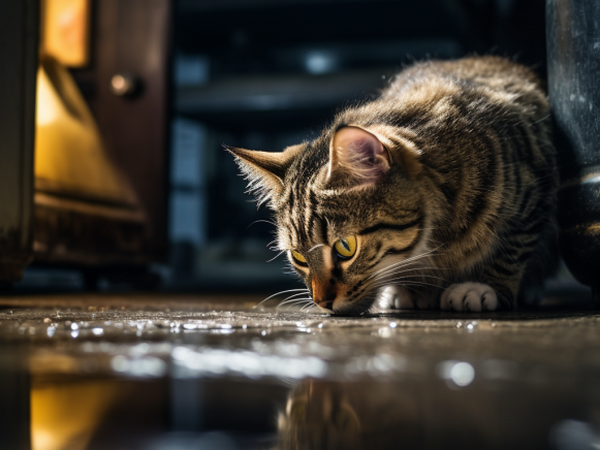How to protect your cat from antifreeze poisoning
First Published: 23/11/2018
Last Updated: 24/01/2024
As the frost begins to settle over our pavements and cars, the use of antifreeze becomes more common. Unfortunately, antifreeze poisoning in cats is a serious risk that cat owners need to be aware of.
In this guide, our vets look at why antifreeze is dangerous to cats, how to keep them safe from antifreeze poisoning and what to do in an emergency.
Why would my cat drink antifreeze?
Antifreeze contains a chemical called ethylene glycol, known for its sweet taste. Although cats don’t taste ‘sweet’ flavours quite as we do, and can be choosy about what they eat and drink, they are curious creatures and may investigate any strange liquid they come across.
Recent studies are questioning the belief that cats and dogs will drink antifreeze out of preference. These studies suggest they're more likely to consume it when no other water source exists. Cats are known for their cleanliness, so another risk is indirect poisoning. They might walk through antifreeze spills and then swallow the chemical while grooming their paws.
Even a small amount of antifreeze can have serious consequences for cats - a fatal dose can be less than a teaspoonful. Given these risks, it's vital for cat owners to keep antifreeze stored safely and to clean any spills promptly. This will help protect your cat from accidental poisoning.
Where would my cat find antifreeze?
Cat antifreeze exposure can happen in several ways, including spills in garages or leaks in household heating systems.
Spillages
If antifreeze leaks or spills when someone's topping up their car radiator, a cat might find it and have a lick. It's sweet-tasting, so cats don't mind the flavour, which is a problem.

From bottles
If a bottle of antifreeze isn't closed properly or is left where a cat can get to it, they might have a sniff and a taste.
From puddles
After a car's radiator has been emptied, there might be puddles of old antifreeze pooling in the garage or street. If a cat walks through it, they'll clean themselves off by licking their fur and paws, and that's how they swallow it.
Inside the house
Some home radiators have antifreeze in them to stop them from freezing. If there's a leak, a cat might drink it or walk through it and lick it off.
In the garden
People sometimes put antifreeze in things like garden water features to stop them from icing over in the cold. If a cat's thirsty, they might have a drink from there.
It's important to keep antifreeze away from where cats can reach. Always store it safely, clean up any spills, and clean any leaks immediately. If you're using antifreeze in your garden, looking for pet-friendly options that won't harm your cat if they have a drink is a good idea.
Why is antifreeze poisonous to cats?
Antifreeze is dangerous for cats because of the ethylene glycol that's in it. When a cat drinks antifreeze, this chemical is rapidly absorbed into the body and is then metabolised in the liver and kidneys to produce acidic compounds. These chemicals are highly toxic, and can also combine with calcium to form large crystals which do further damage to the delicate kidney structures.
That's why it's so important to keep antifreeze away from cats and to act fast if you think they've ingested even the tiniest amount.
Symptoms of antifreeze poisoning in cats
If a cat has antifreeze poisoning, you might see some worrying signs.
- Vomiting
- Lethargy
- Difficulty breathing
- Appearing uncoordinated, almost drunk
- Seizures
- Drinking and urinating a lot (a sign of kidney damage)

Ethylene glycol poisoning is extremely serious for cats, and happens in three stages:
Stage 1
This begins from about 30 minutes to 12 hours after they've ingested antifreeze. Your cat might act as if they're drunk. They could be wobbly, sleepy, vomit, pee more than usual, drink more than usual, feel cold, have fits, or even fall into a coma. This is the most important time to act.
Stage 2
This stage is from 12 to 24 hours after. This stage can be the hardest as some symptoms improve, which may seem like your cat is recovering and pulling through, but sadly this is usually a false improvement. They might be thirsty, have a fast heartbeat, and breathe rapidly because they're becoming dehydrated.
Stage 3
This stage is also from about 12 to 24 hours after they've had antifreeze, and it's the most dangerous stage. The kidneys begin to fail. This has a low survival rate. Your cat will seem very quiet and unwell,, not want to eat, be sick, or have seizures. Sadly, many cats who reach this stage of toxicity die.

What to do if my cat swallows antifreeze?
If you think your cat may have ingested any amount of antifreeze, or you see any of the above symptoms, seek emergency veterinary attention. Your vet can run some urgent blood and urine tests to confirm the diagnosis.
Treating antifreeze poisoning in cats
Treatment options depend on the timing of antifreeze ingestion and potential kidney damage.
If you get to your vet within an hour after ingestion, the likely course of action will be to induce vomiting. Your cat may also be placed onto an intravenous drip to support their kidneys and other internal organs.
In most cases, the vet will use drugs to prevent the ethylene glycol from breaking down and causing its damage. . A drug called fomepizole can be used, but an alternative is ethanol (alcohol). Never administer alcohol yourself, as this can be toxic, too.
Treatment needs to be initiated as soon as possible, as once the ethylene glycol has metabolised and starts damaging the kidneys, the options for treatment become extremely limited. In these cases, dialysis can be an option at some specialist centres.
Time is of the essence with these cases, Kidney damage begins soon after ingestion, and veterinary attention should be sought as soon as possible. Even if the treatment works and your cat gets through it, they might still end up with lifelong damage to their kidneys because of the poison.
How much antifreeze can cause a problem?
It doesn't take much antifreeze to make a cat really sick. Less than a teaspoon is enough to kill. That's why it's so important to mop up any spills immediately, no matter how small.
Once a cat has licked up antifreeze, the ethylene glycol rapidly enters their system. They can start feeling poorly really quickly, sometimes in just half an hour. In other cases, it might take up to 8 hours before you notice they're not right.
Preventing antifreeze poisoning in cats
There are some really simple ways to ensure your cat stays safe around antifreeze.
- Always have a good look at your car to ensure it's not dripping any water coolant because that's often mixed with antifreeze.
- Use antifreeze carefully and ensure your cat (or dog) isn’t around when you’re winter-proofing your car
- When putting antifreeze away, ensure it's tightly sealed in a strong container. Label it so everyone knows what's inside, and keep it somewhere your pets can't get to.
- If you spill any antifreeze, even a tiny bit, clean it up immediately. And keep your pets away from that spot until you're sure it's clean and safe.
- When throwing away any antifreeze or water coolant is time, don't just chuck it in the bin or down the drain. Your local council will have special places to get rid of it safely, so give them a ring, and they'll tell you what to do.
The best way to protect your cat is to be aware and keep harmful toxins, including antifreeze, out of reach.
Are there any studies into antifreeze poisoning in cats?
Yes. One study investigated why animals sometimes drink antifreeze. The researchers wanted to see if animals drink it because they like the taste or because they're thirsty and it's there.
They found that dogs and rats drank less antifreeze as the concentration increased. They didn't prefer it to water, even when they were really thirsty. This suggests that animals don't drink antifreeze because they like it but more because they need water and it's available.
The study also noted that animals are often poisoned by antifreeze, and how much they drink can depend on how strong the mix is. Other things might also affect this, like where the animal lives, if it's bored, or its past experiences. But overall, this study doesn't support the idea that animals drink antifreeze because it tastes sweet. They seem to drink it when thirsty, and it's the only thing around.
While this study was based on dogs and rats, the findings can be transferred to cats. Especially because cats are much more picky than their canine counterparts and will be less likely to drink something they find on the floor.
Is antifreeze poisonous to dogs?
Yes. Much of the information above applies to dogs as well. Dogs aren’t quite as tempted by antifreeze as cats… but dogs will be dogs, after all, so the same rules apply.

Need more advice on the dangers of antifreeze?
If you need further advice, get in touch with your vet – they’ll always be happy to help.
Find your nearest vet using our Find a Vet page, or speak to a vet online using Online Vets.



